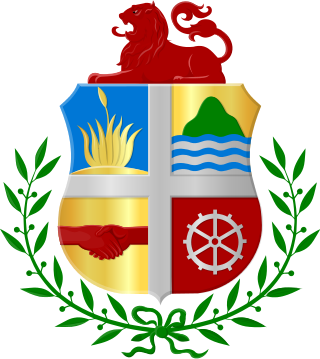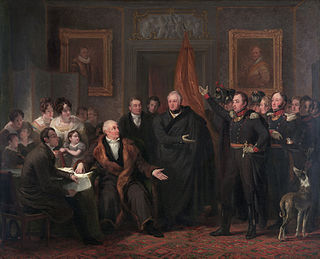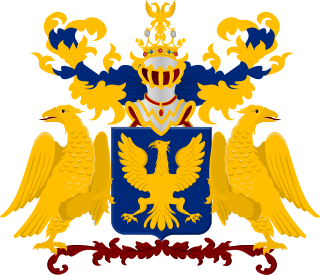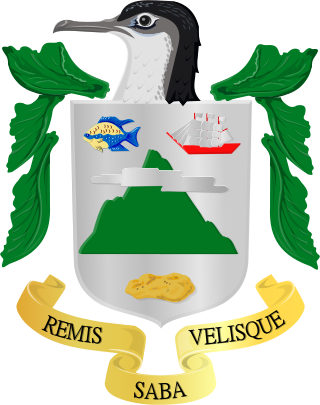
The Coat of arms of Aruba has been officially in use since November 15, 1955, as the recognized national symbol of Aruba.

The Dutch nobility is a small elite social class constisting of individuals or families recognized as noble, and with or without a title of nobility in the Kingdom of the Netherlands.

The coat of arms of Amsterdam is the official coat of arms symbol of the city of Amsterdam. It consists of a red shield and a black pale with three silver Saint Andrew's Crosses, the Imperial Crown of Austria, two golden lions, and the motto of Amsterdam. Several heraldic elements have their basis in the history of Amsterdam. The crosses and the crown can be found as decorations on different locations in the city.

The Netherlands Antilles was an autonomous Caribbean country within the Kingdom of the Netherlands. It was dissolved on 10 October 2010.

The flag of Caribbean Netherlands island of Sint Eustatius (Statia) consists of a blue field, red fimbriations, and in the center, a white diamond with a silhouette of the island. The flag was designed by Zuwena Suares and adopted on 29 July 2004 to be put into use on 16 November of that year. Since 2010, it has been the official flag of the special municipality of Sint Eustatius.

Van Heemstra is a family that belongs to the Dutch nobility.

The Kingdom of the Netherlands, commonly known simply as the Netherlands, is a sovereign state consisting of a collection of constituent territories united under the monarch of the Netherlands, who functions as head of state. The realm is not a federation; it is a unitary monarchy with its largest subdivision, the eponymous Netherlands, predominantly located in Northwestern Europe and with several smaller island territories located in the Caribbean.

The study of Dutch heraldry focuses on the use of coats of arms and other insignia in the country of the Netherlands. Dutch heraldry is characterised by its simple and rather sober style, and in this sense, is closer to its medieval origins than the elaborate styles which developed in other heraldic traditions.

The Caribbean Netherlands is a geographic region of the Netherlands located outside of Europe, in the Caribbean, consisting of three so-called special municipalities. These are the islands of Bonaire, Sint Eustatius and Saba, as they are also known in legislation, or the BES islands for short. The islands are officially classified as public bodies in the Netherlands and as overseas territories of the European Union; as such, European Union law does not automatically apply to them.

The coat of arms of Rotterdam is the official symbol of the city of Rotterdam. It consists of a shield and has a green band of the original weapon of Weena, bisected by a white band symbolizes the Rotte, two golden lions, and four lions, two black and two red on a gold field, and the motto of Rotterdam.

The Identity card BES is a uniform identity card for residents in the Caribbean Netherlands introduced upon the dissolution of the Netherlands Antilles in 2010. The cards are machine-readable and have the size of a credit card. The front contains the words Identiteitskaart followed by the island names Bonaire, Sint Eustatius and Saba. The card also contains the coat of arms of the island of issue.

The coat of arms of Saba was established in 1985 by the island council of Saba, when it was still part of the Netherlands Antilles. It remained the coat of arms of Saba after the dissolution of the Netherlands Antilles, and the subsequent change of Saba's constitutional status into a special municipality of the Netherlands in 2010.

The emblem of Curaçao is a yet to be adopted national symbol of Curaçao. The design will be based on a concept by Adresetti Monart featuring the Queen Emma Bridge, a cactus, a hummingbird and a traditional fishing boat, which was chosen through a design competition held in 2022. The emblem is set to replace the coat of arms of Curaçao, which has been in use since 24 July 1964.

The coat of arms of Bonaire was established in 1986 by the island council, when Bonaire was still part of the Netherlands Antilles. It remained the coat of arms of Bonaire after the dissolution of the Netherlands Antilles and the subsequent change of Bonaire's constitutional status into a special municipality of the Netherlands in 2010.

The Dutch Caribbean are the New World territories, colonies, and countries of the Dutch Empire and the Kingdom of the Netherlands located in the Caribbean Sea, mainly the northern and southwestern regions of the Lesser Antilles archipelago.

The coat of arms of Hoorn is a coat of arms that has been in use since the Middle Ages. Although over time it underwent some changes, there has been no change to the coat of arms since it was acknowledged in use by the High Council of Nobility in 1816. At present, in the original form, it is the coat of arms of the municipality of Hoorn. The current municipality was formed in 1979 by merging the city of Hoorn with the villages Zwaag and Westerblokker; it was decided to use the old coat of arms as coat of arms of the new municipality.

The coat of arms of Zaanstad has been formally acknowledged since 27 February 1974. The coat of arms was previously that of the jurisdictional area of Westsane en Crommenie, which now form the municipality of Zaanstad. These two areas were on the same areas as the municipalities who fused in 1974 to become the municipality of Zaanstad. The municipality of Assendelft alone used a coat of arms who didn't look like those of the other municipalities. The other municipalities and places used a coat of arms with four lions in it.

The coat of arms of Groningen is an official symbol of the province. It was designed when the region was united in 1595 and formally approved in 1947 by Queen Wilhelmina. The coat of arms consists of two lions supporting a crowned shield which is decorated with the shields of the city of Groningen and of the Ommelanden.

The coat of arms of Enkhuizen has been the coat of arms ever since Enkhuizen received borough rights in 1355. The coat of arms was acknowledged in 1816 by the High Council of Nobility, the coat of arms has not been changed ever since.
This page shows the coats of arms, heraldic achievements, and heraldic flags of the House of Nassau.




















